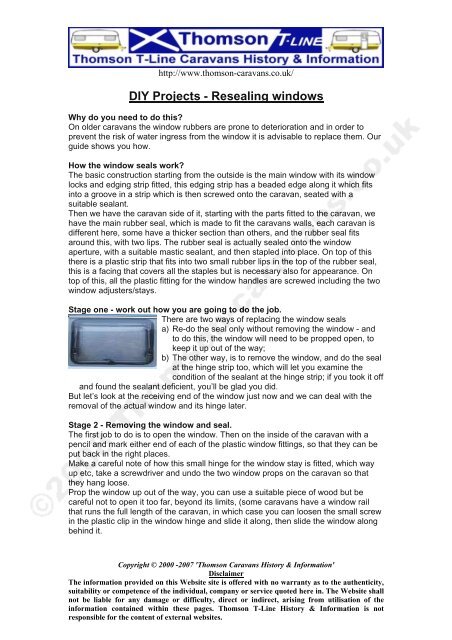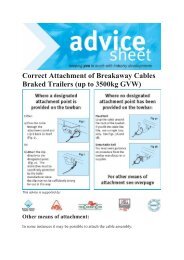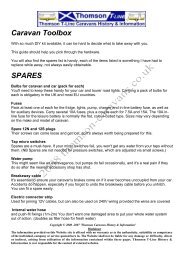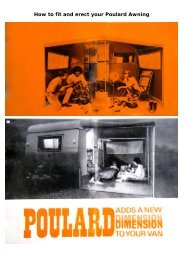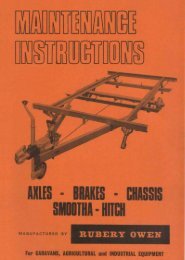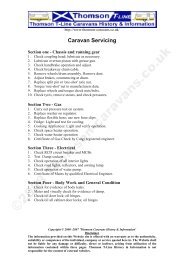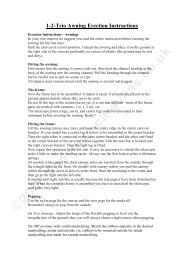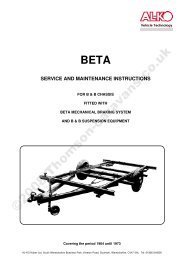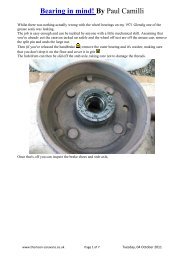Resealing windows - Thomson Caravans
Resealing windows - Thomson Caravans
Resealing windows - Thomson Caravans
Create successful ePaper yourself
Turn your PDF publications into a flip-book with our unique Google optimized e-Paper software.
http://www.thomson-caravans.co.uk/<br />
DIY Projects - <strong>Resealing</strong> <strong>windows</strong><br />
Why do you need to do this<br />
On older caravans the window rubbers are prone to deterioration and in order to<br />
prevent the risk of water ingress from the window it is advisable to replace them. Our<br />
guide shows you how.<br />
How the window seals work<br />
The basic construction starting from the outside is the main window with its window<br />
locks and edging strip fitted, this edging strip has a beaded edge along it which fits<br />
into a groove in a strip which is then screwed onto the caravan, seated with a<br />
suitable sealant.<br />
Then we have the caravan side of it, starting with the parts fitted to the caravan, we<br />
have the main rubber seal, which is made to fit the caravans walls, each caravan is<br />
different here, some have a thicker section than others, and the rubber seal fits<br />
around this, with two lips. The rubber seal is actually sealed onto the window<br />
aperture, with a suitable mastic sealant, and then stapled into place. On top of this<br />
there is a plastic strip that fits into two small rubber lips in the top of the rubber seal,<br />
this is a facing that covers all the staples but is necessary also for appearance. On<br />
top of this, all the plastic fitting for the window handles are screwed including the two<br />
window adjusters/stays.<br />
Stage one - work out how you are going to do the job.<br />
There are two ways of replacing the window seals<br />
a) Re-do the seal only without removing the window - and<br />
to do this, the window will need to be propped open, to<br />
keep it up out of the way;<br />
b) The other way, is to remove the window, and do the seal<br />
at the hinge strip too, which will let you examine the<br />
condition of the sealant at the hinge strip; if you took it off<br />
and found the sealant deficient, you’ll be glad you did.<br />
But let’s look at the receiving end of the window just now and we can deal with the<br />
removal of the actual window and its hinge later.<br />
Stage 2 - Removing the window and seal.<br />
The first job to do is to open the window. Then on the inside of the caravan with a<br />
pencil and mark either end of each of the plastic window fittings, so that they can be<br />
put back in the right places.<br />
Make a careful note of how this small hinge for the window stay is fitted, which way<br />
up etc, take a screwdriver and undo the two window props on the caravan so that<br />
they hang loose.<br />
Prop the window up out of the way, you can use a suitable piece of wood but be<br />
careful not to open it too far, beyond its limits, (some caravans have a window rail<br />
that runs the full length of the caravan, in which case you can loosen the small screw<br />
in the plastic clip in the window hinge and slide it along, then slide the window along<br />
behind it.<br />
Copyright © 2000 -2007 '<strong>Thomson</strong> <strong>Caravans</strong> History & Information'<br />
Disclaimer<br />
The information provided on this Website site is offered with no warranty as to the authenticity,<br />
suitability or competence of the individual, company or service quoted here in. The Website shall<br />
not be liable for any damage or difficulty, direct or indirect, arising from utilisation of the<br />
information contained within these pages. <strong>Thomson</strong> T-Line History & Information is not<br />
responsible for the content of external websites.
http://www.thomson-caravans.co.uk/<br />
Noting the way the fittings go, remove them and keep them safe along with their<br />
screws. Go to the top end of the seal and find the join in the top of the white plastic<br />
now pull it out until the other end is seen, then mark it. (Do not mark it on the rubber<br />
seal – mark it on the interior of the caravan wall, just a small mark is necessary, also<br />
put a small mark or take a note of what way up the seal goes).<br />
Pull out the trim all the way around, and keep it in a safe place. You may be horrified<br />
at what you see when you remove the trim; when I opened mine up I found that ALL<br />
the staples at the lower part of the window had rusted away, this may not necessarily<br />
be that the caravan has rusted them all – remember that you caravan <strong>windows</strong> can<br />
get steamed up at night or in wet weather, this is all it takes, through time.<br />
Stage 3 - check the sealant.<br />
Go around the lip of the seal that is in contact with the body of the caravan, and pull it<br />
back a little if possible, if no sealant sticks to your fingers then you need to replace<br />
the sealant, using a screw driver, go around the staples and lever them up a bit, you<br />
will find that some will break and some will be non-existent, just lever up what you<br />
can. Go around with a pair of pointed pliers and pull them out, don’t worry about the<br />
stubs that you can’t get. Go to the middle, bottom of the window seal and find the<br />
join, pull one end up, and have a look at how it fits, and then carefully peel it back all<br />
the way around, put it somewhere safe. Get the ordinary pliers and go around the<br />
window opening pulling out all the stubs of the staples that couldn’t be removed<br />
earlier.<br />
Check the timber and re-seal.<br />
How does the timber in the frame look Is it dry and sound If so, good!<br />
Go around the window opening with a chisel or a wide flat bladed screwdriver and<br />
scrape away all of the sealant that is left, it will probably look like putty but not sticky,<br />
be careful when removing it from the outside metal panelling of the caravan; just<br />
remove the most that you can, then use petrol or white spirit to clean the rest.<br />
Open the tube of Sikaflex and load it into the gun, and go around all the holes in the<br />
wood filling them with the glue, if you find the metal coming away from the wood in<br />
the frame, use a little Sikaflex to glue it back too.<br />
The rubber window seal now needs to be cleaned and examined, just scrape off the<br />
excess sealant, then go around looking at the general condition of the rubber, check<br />
for splits and perished areas – Watch out for staples still stuck in the rubber. Clean<br />
the white plastic strip too; the rust from the staples can be cleaned out using a wire<br />
brush.<br />
The tools you need.<br />
Replacing the window mastic is not easy, and it is time consuming, there are a lot of<br />
things to remember and a dry sheltered area is required, it is not the sort of job you<br />
can just do out side on a whim, even if the weather is excellent at the time.<br />
Copyright © 2000 -2007 '<strong>Thomson</strong> <strong>Caravans</strong> History & Information'<br />
Disclaimer<br />
The information provided on this Website site is offered with no warranty as to the authenticity,<br />
suitability or competence of the individual, company or service quoted here in. The Website shall<br />
not be liable for any damage or difficulty, direct or indirect, arising from utilisation of the<br />
information contained within these pages. <strong>Thomson</strong> T-Line History & Information is not<br />
responsible for the content of external websites.
The tools needed are as follows:<br />
http://www.thomson-caravans.co.uk/<br />
A good selection of screwdrivers<br />
A good pair of pliers<br />
A good quality staple gun with 10 – 14mm staples<br />
A small hammer<br />
A selection of chisels (they don’t have to be sharp)<br />
A pair of vice grips (you’ll find out why, later)<br />
Some petrol and some good but, old cloths<br />
A sealant gun<br />
A small tub to put small parts into<br />
A bin<br />
A tube of IDL99 sealant<br />
A tube of Sikaflex adhesive/sealant<br />
A drill/driver and screwdriver bits<br />
A set of HSS drill bits<br />
A few pairs of rubber/latex gloves, and some old clothes, and<br />
A Stanley scraper with its plastic blade.<br />
Copyright © 2000 -2007 '<strong>Thomson</strong> <strong>Caravans</strong> History & Information'<br />
Disclaimer<br />
The information provided on this Website site is offered with no warranty as to the authenticity,<br />
suitability or competence of the individual, company or service quoted here in. The Website shall<br />
not be liable for any damage or difficulty, direct or indirect, arising from utilisation of the<br />
information contained within these pages. <strong>Thomson</strong> T-Line History & Information is not<br />
responsible for the content of external websites.


